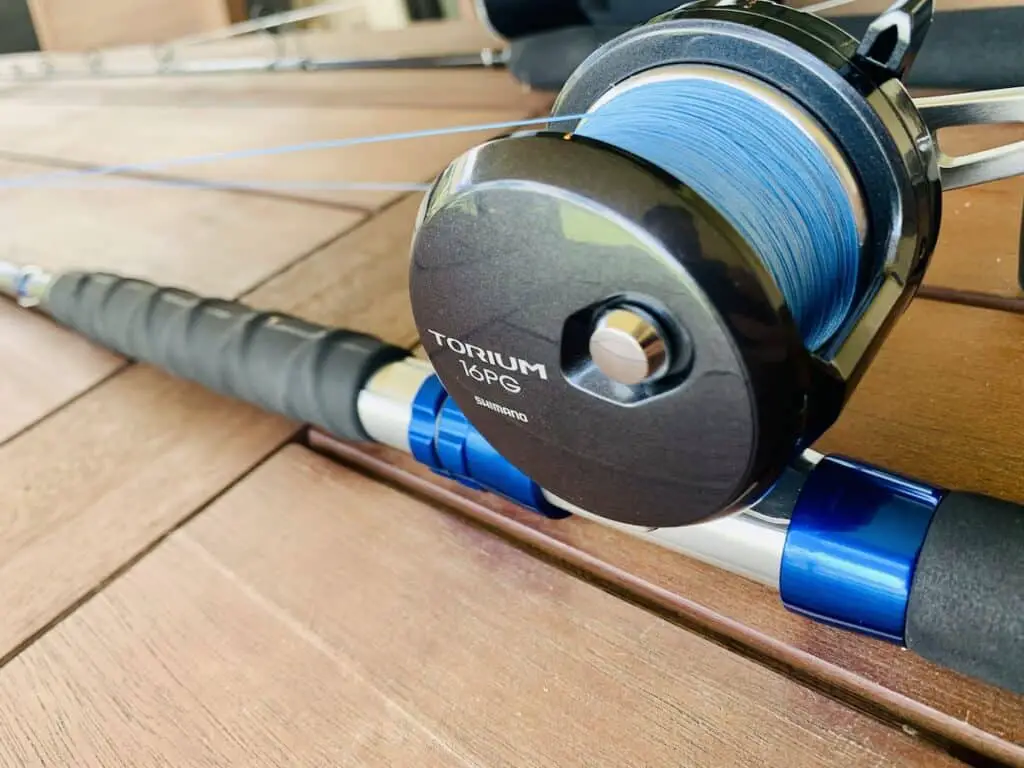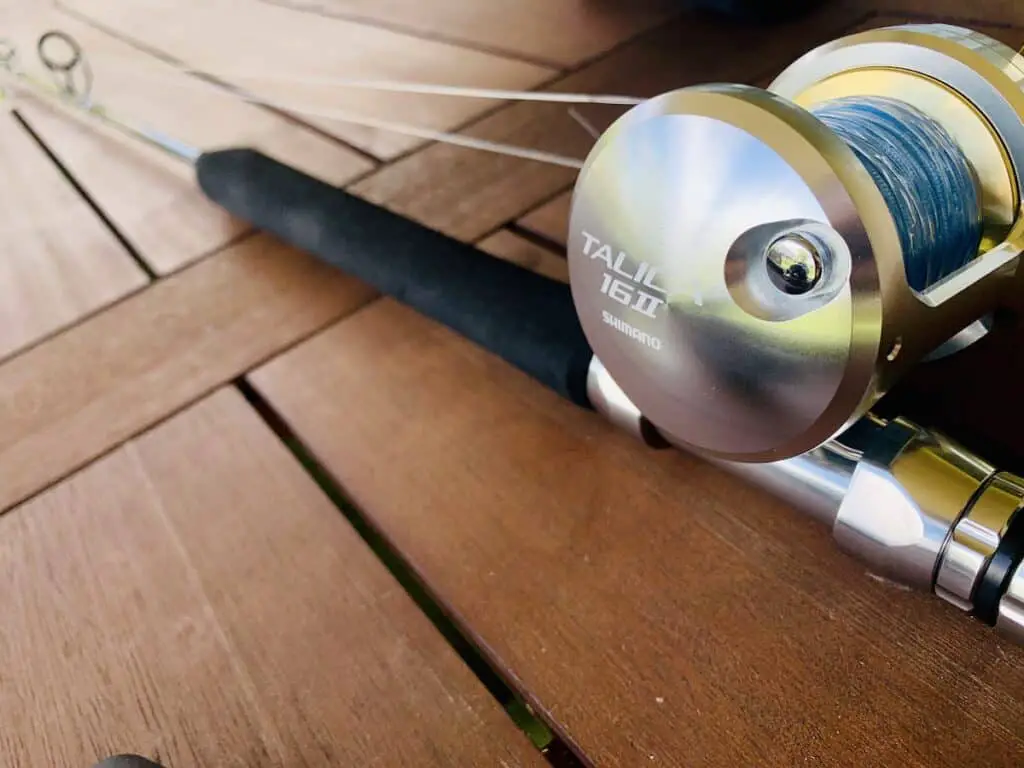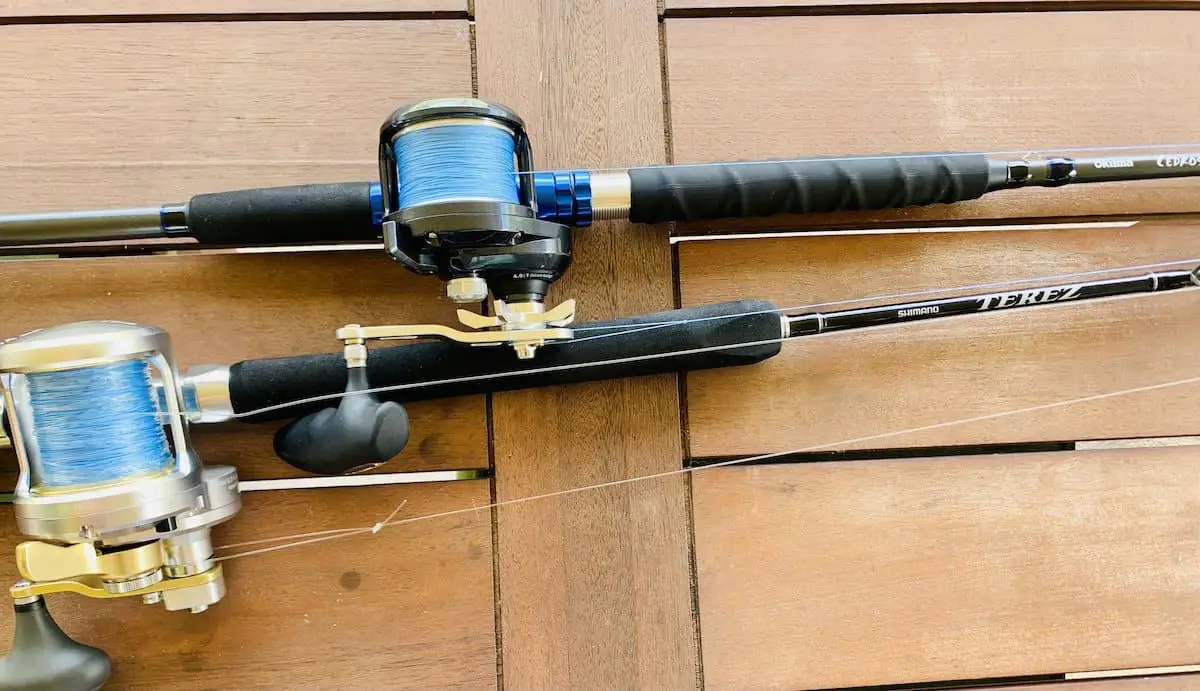Finding the proper rod and reel for a bottom fishing setup is honestly more difficult than it should be. It’s hard to find a rod that’s labeled a “bottom rod”, and more likely you’ll buy something like a generic boat rod or a jigging rod with the ideal power and action for bottom fishing.
This article will cover 3 bottom fishing rod and reel combinations. One will be a budget option, one is a mid-price point option, and one is a higher end pairing. I’ll talk you through how to choose the right sized reel and how to find an appropriate sized rod for it. Two of these setups are ones I personally own and am very happy with.
Budget Combo: Shimano TLD Triton Lever Drag Reel + Ugly Stik Bigwater Rod Combo
The Shimano TLD conventional reel is a great reel for the price. There are 3 sizes, the 15, 20, and 25 which vary in price from $160-$200. The TLD is known for its reliability. These reels are the preferred lever drag reel of many anglers looking for an affordable and reliable reel to get started with offshore fishing.
The line capacity on a Shimano TLD easily surpasses the competition. The line capacity and the clicker makes this reel a go-to choice for both bottom fishing and trolling applications.
The max drag is a little low on these reels. I would normally fish 65 lb braid and set my drag at strike to about 16 lbs. These reels will work for those settings, but you may notice over time your drag degrades. Whenever you get to the point where you can no longer set your drag to where you want it, you can either take the reel in to service for new drag washers, or deal with a slightly lower drag setting.
Another option would be to decrease the line strength and fish in shallower waters for smaller bottom fish. This will also work, you’ll just have more line capacity than you need. I recommend reading my article on Bottom Fishing Line to learn what line strength is best for bottom fishing. The article also discusses how to choose leader line strength and length.
As a budget option, I recommend pairing this reel with the line of Ugly Stik Bigwater Conventional rods. This rod has heavy power and works well with the 65 lb test braided line I recommend using for bottom fishing. Although I’ve recommended pairing with a 6’6” rod, you could choose the 7’ option if you plan on fishing from a party boat. Additional length is usually helpful on a party boat where you’ll sometimes need to maneuver around other rods.
| Reel Size/model # | Line Capacity | Gear Ratio | Max Drag @ Strike | Line Rating | Power | Rod Model # | Rod + Reel Price |
| TLD-15 | 65/530 | 4.0:1 | 15 | 40-80 | H | BW4080C661 | $240 |
| TLD-20 | 65/745 | 3.6:1 | 17 | 40-80 | H | BW4080C661 | $260 |
| TLD-25 | 65/980 | 3.6:1 | 17 | 40-80 | H | BW4080C661 | $280 |
When bottom fishing, a low gear ratio is ideal because it’ll give you immediate power after strike to fight back against a grouper or snapper darting back into the structure. The TLD has a very low gear ratio which will give you plenty of power. The drawback is a very slow retrieve rate. It's difficult to find a reel with truly ideal specs at this price point, but the Shimano TLD will give you the power and the line capacity you need for bottom fishing.
Medium Price Point Combo: Shimano Torium Reel + Okuma Cedros A Series Rod
The first thing you’ll notice when the budget increases is the improved max drag capability of the reel. The Shimano Torium reel will get 31-33 lbs of max drag depending on the size, which is substantially more than the TLD’s 15-17 lbs. This gives you the flexibility to spool the reel with anywhere from 65 to 80 lb braid, which are all ideal line strengths for bottom fishing offshore.

The Torium has a star drag system. In a star drag system, the drag washers are located on either side of the drive gear which is offset from the larger main gear. This means the drag washers are smaller, but high max drags can still be achieved with what’s called a drag stack.
A drag stack is a series of washers, some metal and some carbon fiber, that are slow the rate of line leaving the spool with the friction created when the washers turn against each other. Any type of drag system will work for bottom fishing, and the more important feature to consider is the maximum drag capability.
The drag setting should be 25-30% of the line strength, or 16-24 lbs. The Torium has plenty of margin to set the drag at the ideal setting and not have to worry about maxing out your drag. This will be helpful if you need to increase your drag when you hook a big one or if you decide to spool your reel with heavier line.
| Reel Size/model # | Line Capacity (lb/yd) | Gear Ratio | Max Drag (lbs) | Line Rating | power | action | Rod Model # | Rod + Reel Price |
| 16/TOR16PGA | 65/330 | 4.6:1 | 33 | 50-100 | MH | MF | CJ-C-661-MHa | $375 |
| 20/TOR20PGA | 65/375 | 4.6:1 | 33 | 50-100 | MH | MF | CJ-C-661-MHa | $385 |
| 30/TOR30PGA | 65/515 | 4.6:1 | 33 | 50-100 | MH | MF | CJ-C-661-MHa | $395 |
| 40/TOR40PGA | 65/920 | 3.9:1 | 31 | 65-150 | H | MF/F | CJ-C-661-Ha | $505 |
Most of the time, the difference in reel size is primarily attributed to line capacity. If you’re in the market for a reel and need help figuring out how much line capacity you really need, read my article Bottom Fishing Reels: Read Before You Buy to learn how to estimate your need.
As an example, I know I’ll frequently be bottom fishing off the East Coast of central Florida where the reefs and wrecks are about 120 yards deep. I’ve noticed that the shops where I get my reels spooled can never quite hit the line capacity numbers, so I like to have some margin to accommodate that. I also need some additional line for when a fish will run. For my usual area, where I bottom fish in depths of about 120 yards, the size 16 Torium is a good fit.
If you’re familiar with the Shimano Torium models, you may notice that the table only includes the “PG” models. These are the lower gear ratio models, which are a better fit for bottom fishing. A lower gear ratio means the gears have bigger teeth. Bigger teeth can handle stronger loads, and provide more torqueing power.
Once you hook into a grouper or snapper, you’ll need to start retrieving to keep them away from the structure. They’re strong fighters and the power of a low gear ratio reel will keep the ball in your court.
To pair your Torium with a rod, you’ll need to make sure the rod power supports your line strength. The line rating provides a pretty good guide to this, and you’ll notice that as the power rating of the rods increase, so does the line rating.
For the size 16, 20, and 30 Torium, you’ll likely be using 65 lb test braid and the medium heavy power rod will provide the backbone you need. The size 40 Torium has much higher line capacity, so you could spool that reel up with 80 lb test braid and still have a good amount of line capacity. If you go up to 80 lb test braid, I’d recommend pairing it with a heavier power rod, the heavy model Okuma Cedros A.
The Okuma Cedros A rods all have moderate fast or moderate fast to fast action. This provides a flexible tip that works well to tire out strong bottom dwellers. The 6’6” length perfectly gives you the distance away from the edge of the boat without becoming a difficult rod to store.
These rods all have a split grip, meaning there is a section of exposed rod blank between two EVA sections below the reel seat. The EVA below the reel seat is big enough for my hand to grip and the split grip reduces the overall weight of the rod.
The rod butt end does not have a gimbal and instead has a rubber butt cap. Since the Toriums are lightweight reels, and the rod does not have a gimbal, this setup will be best used for stand up fishing. The rubber butt cap is wide enough to spread the pressure out to avoid bruising your body.
Rod construction is another feature I like about this rod. The Cedros A rod is made of E-glass which dampens the shock of a darting bottom dweller. Since you’ll spool your line with braid, and likely have a short leader, you’ll need some shock absorption in the system to prevent any breakoffs. In this setup, the shock absorption comes from the E-glass construction of the rod blank.
High end combo: Shimano Talica Reel + Shimano Terez Rod
An increased budget can get you the coveted Shimano Talica 2 speed reel. The Talica is an extremely durable 2 speed reel built to withstand harsh saltwater conditions. The reel has a compact body which proves to be helpful when holding the reel while bottom fishing. The reel has shielded stainless steel ball bearings designed to last nearly forever with minimal maintenance, even when used in saltwater.
The Talica has higher line capacity than the Torium of similar size. High line capacity in a compact package is a big advantage in my mind because you can maximize the water depths in which you can use the reel. I bought the size 16 Talica to use in the same waters I mentioned above, about 120 yards of depth, but I will also be able to use the reel when we fish deeper waters on the Atlantic side of the Keys.

Along with the higher line capacity advantage, the reel also has higher drag than the other two reels. With higher drag, you can use higher line strength to target bigger fish. The Talica has a lever drag system. A lever drag system uses drag washers against the side of the spool and the drag preset knob, as well as the lever position, determines the amount of pressure used to press the drag washer against the spool.
A lever drag system works well for bottom fishing and generally supports higher max drags because of the larger surface area of drag washers. In a lever drag system, the larger surface area of the drag washers also helps dissipate the heat generated when the drag is engaged. This will help keep the reel from overheating in your hand.
The advantage of a two speed reel for bottom fishing is clear. The lower gear ratio should be used when the fish strikes to give the angler the power to keep the bottom fish away from the structure. The higher gear ratio and fast retrieve will help bring in an empty line much faster. It can take a long time to reel in hundreds of yards of line when bottom fishing and you’ll be thankful you have the option to speed it up.
As far as which rod to pair with a Talica for bottom fishing, I recommend the Shimano Terez. It is built with Shimano’s Hi-Power X and Spiral-X construction to give it high torsional strength. This will help the rod hold up under the pressure of a bottom fish moving back and forth.
The Terez rod also has Fuji guides with titanium frames and alconite ring inserts. The titanium frames keep the guides extremely lightweight and the alconite rings are durable enough to withstand contact with sharp braid.
Another feature that upgrades this setup is the aluminum gimbal on the rod. In all likelihood, if my wife ever uses this setup, it’ll be hard for her and she’ll want to crank it while wearing a fighting belt. The aluminum gimbal has notches that mate with the crosspins in my the fighting belt and prevents the rod from twisting as she’s winding the handle. It gives a strong feeling of security and keeps the leverage in the angler’s favor.
If you’d like to fight a fish standing up without a fighting belt, you can easily slide on something like a cush-it to protect your body from the harsh metal gimbal.
The table below shows which Terez rod model I recommend pairing with which Talica reel model. The Talica size 20 holds significantly more line and has different gearing than the lower sizes. I’d most likely be putting 80 braid on a size 20 Talica and targeting grouper over 40 lbs. For fish like this, you’ll want the extra heavy power to give you much needed backbone for the fight.
| Reel Size/model # | Line Capacity (lb/yd) | Gear Ratio | Max Drag @ full (lbs) | Line Rating | power | action | Rod Model # | Rod + Reel Price |
| 12/TAC12II | 65/400 | 5.7:1 High 3.1:1 Low | 40 | 50-150 | H | F | TZC66H | $880 reel |
| 16/TAC16II | 65/485 | 5.7:1 High 3.1:1 Low | 40 | 50-150 | H | F | TZC66H | $890 reel |
| 20/TAC20II | 65/725 | 5.2:1 High 2.3:1 Low | 45 | 65-200 | XH | F | TZC66XH | $980 |
I hope this article helps you decide on a bottom fishing rod reel pairing. If you’d like to read more detail about rods for bottom fishing, read my article Bottom Fishing Rod Features. Don't forget to also check out my overall bottom fishing guide article here. Tight lines, y’all!
Recent Posts
Fat Cow Jig Strips: The Ultimate Bucktail Jig Upgrade for Surf Fishing
As discussed in my previous article, "Surf Fishing with Bucktail Jigs: Ultimate Guide for Beach Anglers," bucktail jigs are a staple in any surf angler's tackle box, offering a versatile way to catch...
In my previous article, "Surf Fishing with Bucktail Jigs: Ultimate Guide for Beach Anglers," I introduced you to the bucktail jig and discussed how versatile of a lure it is for catching a wide range...

